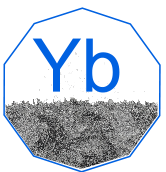Ytterbium

Ytterbium (Yb)
General Information
- Symbol: Yb
- Atomic Number: 70
- Atomic Weight: 173.045 u
- Element Category: Lanthanide
- Group: N/A (Lanthanides series)
- Period: 6
- Block: f-block
Physical Properties
- Appearance: Silvery-white metallic
- Density: 6.90 g/cm³
- Melting Point: 824 °C (1515 °F)
- Boiling Point: 1196 °C (2185 °F)
- Phase at STP: Solid
- Electron Configuration: [Xe] 4f¹⁴ 6s²
- Oxidation States: +2, +3 (most common)
Chemical Properties
- Reactivity: Ytterbium is relatively stable in air but can slowly tarnish. It reacts with water to form ytterbium hydroxide and with acids to form ytterbium salts.
- Compounds: Forms compounds such as ytterbium(III) oxide (Yb₂O₃), ytterbium(III) chloride (YbCl₃), and ytterbium(III) nitrate (Yb(NO₃)₃).
Uses and Applications
- Lasers: Ytterbium-doped lasers are used in materials processing, medical procedures, and telecommunications.
- Nuclear Reactors: Used as a neutron absorber in nuclear reactors.
- Alloys: Added to stainless steel to improve its grain refinement and mechanical properties.
- Catalysts: Used in various catalytic processes in the chemical industry.
- Medical Devices: Ytterbium isotopes are used in certain medical imaging and treatment applications.
Occurrence and Extraction
- Natural Occurrence: Found in minerals such as xenotime, euxenite, and monazite, often alongside other rare earth elements.
- Extraction: Extracted through complex processes involving the crushing of ore, magnetic separation, and solvent extraction.
Isotopes
- Stable Isotopes: Ytterbium-168, Ytterbium-170, Ytterbium-171, Ytterbium-172, Ytterbium-173, Ytterbium-174, Ytterbium-176 (most stable)
- Radioactive Isotopes: Several radioactive isotopes, including Ytterbium-169 and Ytterbium-175, used in research and medical applications.
Safety and Handling
- Hazards: Ytterbium compounds are considered to have low toxicity, but dust and powders should be handled carefully to avoid inhalation or ingestion. Metallic ytterbium can be a fire hazard in powder form.
- Precautions: Use appropriate protective equipment when handling ytterbium and its compounds.
History
- Discovery: Discovered by Jean Charles Galissard de Marignac in 1878.
- Name Origin: Named after the village of Ytterby in Sweden, where the mineral ytterbite (which contains ytterbium) was found.
Additional Facts
- Crystal Structure: Face-centered cubic (fcc)
- Magnetic Properties: Paramagnetic
- Thermal Conductivity: 38.5 W/m·K
- Electrical Resistivity: 0.25 µΩ·m at 20°C
Summary
Ytterbium is a versatile lanthanide with a wide range of applications in industry, medicine, and technology. It is particularly valuable in lasers, nuclear reactors, and various alloys. Discovered in 1878 and named after the Swedish village of Ytterby, ytterbium is found in several minerals and requires careful handling due to its reactive nature.
40 Question and Answer Pairs About Ytterbium
What is the atomic number of Ytterbium?
- 70
What is the symbol for Ytterbium?
- Yb
What is the atomic weight of Ytterbium?
- 173.045 u
In which group of the periodic table is Ytterbium found?
- Lanthanides series (no specific group)
What period is Ytterbium in?
- Period 6
What block does Ytterbium belong to?
- f-block
What is the density of Ytterbium?
- 6.90 g/cm³
What is the melting point of Ytterbium?
- 824 °C (1515 °F)
What is the boiling point of Ytterbium?
- 1196 °C (2185 °F)
What is the electron configuration of Ytterbium?
- [Xe] 4f¹⁴ 6s²
What are the common oxidation states of Ytterbium?
- +2, +3 (most common)
What is the appearance of Ytterbium?
- Silvery-white metallic
Is Ytterbium reactive with air?
- Relatively stable, can tarnish slowly.
Name a compound of Ytterbium.
- Ytterbium(III) oxide (Yb₂O₃)
What is a common use of Ytterbium in lasers?
- Ytterbium-doped lasers for materials processing and medical procedures.
How is Ytterbium used in nuclear reactors?
- As a neutron absorber.
What role does Ytterbium play in alloys?
- Added to stainless steel to improve properties.
How is Ytterbium used in catalysts?
- Used in various catalytic processes in the chemical industry.
What is a medical application of Ytterbium isotopes?
- Used in medical imaging and treatment.
How is Ytterbium typically found in nature?
- In minerals such as xenotime, euxenite, and monazite.
What are the stable isotopes of Ytterbium?
- Ytterbium-168, Ytterbium-170, Ytterbium-171, Ytterbium-172, Ytterbium-173, Ytterbium-174, Ytterbium-176
What safety hazard is associated with Ytterbium dust?
- It can be a fire hazard.
Who discovered Ytterbium?
- Jean Charles Galissard de Marignac
Where does the name Ytterbium come from?
- Named after the village of Ytterby in Sweden.
What is the crystal structure of Ytterbium at room temperature?
- Face-centered cubic (fcc)
Is Ytterbium paramagnetic or diamagnetic at room temperature?
- Paramagnetic
What is the thermal conductivity of Ytterbium?
- 38.5 W/m·K
What is the electrical resistivity of Ytterbium at 20°C?
- 0.25 µΩ·m
What is the primary oxidation state of Ytterbium in its compounds?
- +3
Is Ytterbium found as a free element in nature?
- No, it is found in minerals.
What is the common name of Ytterbium(III) chloride?
- YbCl₃
What is a major application of Ytterbium in lasers?
- Ytterbium-doped lasers for telecommunications and medical procedures.
How does Ytterbium benefit the nuclear industry?
- As a neutron absorber.
What is the melting point of Ytterbium in Kelvin?
- 1097 K
What group does Ytterbium belong to in the periodic table?
- Lanthanides series
What is the natural abundance of Ytterbium-173?
- It is one of the stable isotopes.
Can Ytterbium be used in high-temperature applications?
- Yes, particularly in alloys.
What is the key property that makes Ytterbium valuable in lasers?
- Its ability to amplify light in fiber-optic communications.
How is Ytterbium used in the chemical industry?
- Mainly in research and specialized applications.
What precautions should be taken when handling Ytterbium?
- Use appropriate protective equipment to avoid inhalation or ingestion.






